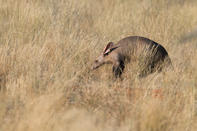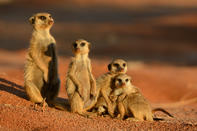Tswalu Foundation
The Kalahari is a place we go to dream and to lose ourselves in the vastness of a system that is greater than our rational thought.

One area where the new custodians have taken the restoration of Tswalu to a higher level is on the ecological side. The Tswalu Foundation is the supporter of a substantial field programme, each project linked to research at academic institutions locally and around the world. Subjects include black rhino reintroduction, scorpions, reptiles, several bird projects, dung beetles and pangolins.
Unparalleled Game Viewing

Never more than 30 guests at a time can ever enjoy the natural wonders of this exquisite assemblage of fascinating landscapes and organisms. That's just one person for every 30 square kilometres of Kalahari wilderness: an experience as far removed from a safari to somewhere like the Ngorongoro Crater as visiting Antarctica is to Grand Central station.
Consequently, you have unparalleled game viewing, including, the reserve manager Gus van Dyk proudly asserts, the best chances of seeing those ghostly creatures of the arid regions, aardvark and pangolin. The sparse winter grass cover means that when these two nocturnal creatures abandon their usual nightly activities to go foraging in warm mornings, they are fairly easy to spot.
See Animals in Their Perfect Habitat

Tswalu is also among the best places in Africa to see cheetahs in the wild, in their perfect habitat - wide-open grasslands. And of course black rhinos which are just about everywhere else stepping gingerly along the fringe of extinction. The diversity of habitat (and climate) has resulted in an extremely diverse animal population.
There are about 80 species of mammals and approximately 240 species of birds. The open habitat makes for excellent game viewing. It is usually the two colonies of partially habituated meerkats that thrill visitors even more than some of the larger hairy or horny residents.
Meerkats are part of the mongoose family, whose mannerisms and social behaviour make them among the most endearing of African animals. The two colonies here can be approached much more closely than is generally possible, and the photographic opportunities presented are often the highlight of a stay.
By David Bristow The malaria free, private game reserve has two luxury lodgings that together can accommodate a maximum of 28 guests....
The malaria free, private game reserve has two luxury lodgings that together can accommodate a maximum of 28 guests.... The vast, arid Kalahari is Southern Africa's terra incognita, a place of dreaming and of legends. The Kalahari arid savanna covers most of e...
The vast, arid Kalahari is Southern Africa's terra incognita, a place of dreaming and of legends. The Kalahari arid savanna covers most of e...